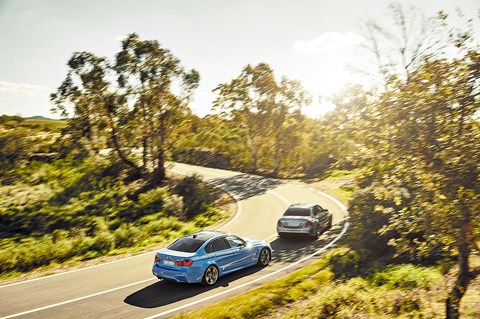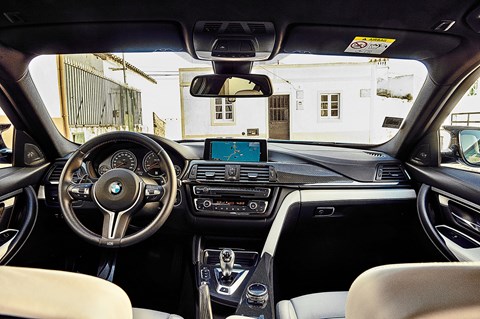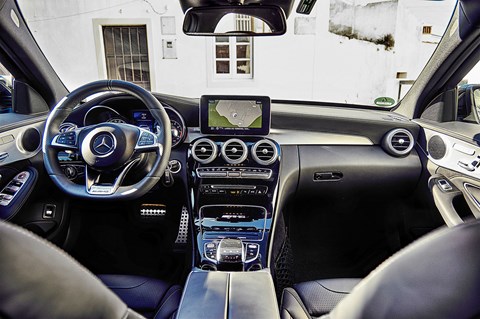► Title fight: M3 vs C63 AMG
► Four-door super-saloons slug it out
► Will M3 rue the day it dropped V8?
M3 owns this territory, but it has a real fight on its hands now. The new C-class has picked up a bunch of fresh virtues. It steers with more enthusiasm, it brakes with more bite, it puts the power down with more determination and, most importantly, it handles with a delicate sweetness none of its nose-heavy, tail-happy predecessors ever came close to. And now it’s got a twin-turbo V8 and an AMG badge too. Gulp.
It’s not as if the M3 is at its most confident right now. The only reason it even still exists is on the strength of its badge – otherwise it would have been dinked for the more dynamic looking and more profitable Gran Coupe – and its whiny, downsized six-pot turbo engine isn’t exactly Ant & Dec in the personality stakes.
The new C63 also has the advantage of a much more linear, less schizophrenic bloodline than the M3. This Merc can trace its roots to the C36 launched in 1993 or, with a nostalgic wink, to the 190E 2.3-16. While most M3 generations tended to be street-legal competition cars – think Sport Evo, GT, CSL, GTR and GTS – it was exactly the other way round with the likes of C32, C43, C55 and, ultimately, C63. If you discount a few late counter-attacks (Black Series, CLK DTM, edition 507), this side of the SLS and the GT the AMG brand typically focuses on fast grand tourers.
Not surprisingly then, the new C63 is exactly that.
Mercedes-AMG C63 vs BMW M3: CAR magazine’s twin test
In the last six months BMW and Mercedes launched M3 and C63 on the same racetrack, the Autodromo do Algarve in Portimao. Here, both cars charm you with a subtle handling balance much more figure skater than ice-hockey defenseman. It’s this near-perfect flow which makes the difference, the readily accessible fusion of dynamic attitudes, the reduced input required to set up the car for the next bend. Press on, and it’s the BMW that first rolls up its sleeves. After all, the M3 is not just about time-warping itself from corner to corner, it’s also about grand gestures, loud behaviour, an extrovert stance. By contrast, the C63 epitomises composure and civilised behaviour.
But this comparison is not about track-day suitability, it’s about early Sunday mornings when you leave the house with itchy palms, a dry mouth and a thumping heart, ready to reel in that favourite stretch of country road. In that mood I find in my garage this morning a baby blue metallic M3 and a silver C63 AMG. And boy does the Merc look the business. The AMG designers love a generous touch of bling, and the C63 delivers. Its go-faster make-up includes additional brightwork, larger air intakes, more sculptured bumpers, air deflectors front and rear, 19in wheels and trademark quad tailpipes. To make room for the V8 engine, the nose of the car had to be lengthened by 71mm which required several modifications, among them bespoke front wings. Depending on personal preference, you can specify a sumptuous cabin trim or a pseudo-racing ambience with high-back bucket seats, red belts and carbonfibre accents. Sadly, there is no way to get rid of the column-mounted gear selector, which kind of lets the car down, but take solace from the top-notch materials, impeccable fit and finish and compelling extras such as variable-intensity LED headlamps.

In terms of perceived quality, the M3 lags behind. The instrument panel is a mix of classy and not so classy surfaces, some of the plastics and rubber seals are positively low-rent, the ergonomics are ho-hum in places (gear selector, secondary controls, main dials), and you don’t expect such cheap boot trim or a bonnet painted only on the outside. Admittedly, our test car provided by a local dealer was not a prime specimen. The brakes had seen better days and the aftermarket Michelins were not the softer compound tyres fitted by the factory. The only fault we could find with the C63 was a rattling front suspension noise triggered by really rough roads.
While Mercedes won’t charge you for the Speedshift automatic gearbox or for the adjustable Ride Control dampers, the adaptive M suspension and the dual-clutch transmission offered for the M3 cost extra. Which brings the grand total for both cars very close to an identical £59,000. That’s a lot of money, but the only serious rival – the ageing 450bhp Audi RS5 – is even more expensive.
C63, M3 specs, performance figures. Which is faster?
Performance-wise, these two compact supersaloons celebrate the high art of the dead heat. Acceleration? 0-62mph in 4.1sec. Top speed? Governed at 156mph; or 175mph (M3) and 181mph (C63) with the Driver’s Package box ticked. Fuel consumption? On paper, the BMW edges the Mercedes by 34mpg against 33.6. In real life, the gap widened to 17mpg against 14.8. No, we spent no time on the track, but 50 miles on the autopista a grande volocidade and half a day on winding roads in the hilly hinterland of Faro. For one life cycle only, BMW did replace the straight-six with a V8, but for this fifth-generation M3 they’ve ruefully returned to the classic formula, for the first time in conjunction with a couple of turbochargers. The brand-new 3.0-litre engine develops 431bhp from 5500 to 7300rpm. The Merc’s 4.0-litre unit delivers 476bhp between 5500 and 6250rpm. Redlined at 7000rpm, the 32-valver cannot quite match the 7600rpm which marks the Game Over limit of the M3. Having said that, the V8’s torque delivery flatlines from 1750 to 4500rpm, whipping up a mighty 479lb ft – 74lb ft more than the peak twist action generated by the M3, which spreads its oomph summit over an even wider 1850 to 5500rpm range. So why does the more potent Mercedes not outsprint the BMW? Because at 1640kg, it’s 45kg heavier. And because its transmission – a blend of wet take-off clutch and seven-speed automatic – does not shift quite as energetically as the M3’s seven-speed DCT.
So far, blue and silver are pretty evenly matched. The first clear distinction is brought about by the drivetrains. For a start, the 1000cc difference in displacement swings the pushing power pendulum in the direction of the Benz. Although the extra torque works wonders for the in-gear acceleration, it’s not so much the initial impact that does the trick but the brute force that follows. The gear ratios are quite similar, and both cars invite you to adjust the shift speed from pursed-cogs-lissom to kick-in-the-butt-radical. To change the set-up, the BMW driver must hit a knob below the joystick. In the Benz, Dynamic Select can be locked in Comfort (coasting under lift-off, active stop/start) Sport, Sport+ or Individual. In addition to masterminding the gearbox, the drive mode selectors will psych up the engine, shock absorbers, steering, ESP and the exhaust note. The helm of the M3 incorporates two buttons labelled M1 and M2 which store and summon your favourite vehicle attitudes. In both cars, key functions can also be accessed directly via separate controls in the centre console.

The V8 wins the torque duel, but it’s the six-cylinder that manages a seamless transition from peak torque to peak power which merge at 5500rpm. At this point, you still have 1800rpm to play with, which keeps the adrenalin flowing and treats the ears to a beautiful noise. But while its powerband is broader and more explosive at the bottom end of the rpm range, the BMW gains zero ground over the smoother-shifting Mercedes. Although both units have melodical talent, the sound engineers dialled in rather too much computer-generated background music. There’s fake heeling-and-toeing, fake blat-blat on override, fake upshift ka-chumm, fake idle speed thud. For the AMG car one can specify an even more hooliganesque triple-flap exhaust which sounds positively puerile. The Mercedes has a subjective acceleration advantage between 60 and 100mph when the extra grunt seems to give it marginally stronger and longer legs. We also liked the short-term M mode which freezes the transmission in manual for as long as you keep using the shift paddles. Another plus point goes to the extra-fast downshift function which selects the lowest possible gear when the left paddle is pulled and held.
Even in Comfort mode, the M3 simply hates uneven surfaces. How do we substantiate this criticism? By no longer counting the number of times the ESP warning light comes on when you give this thing stick. One does want ESP to be active on slippery stuff and through bad surprise corners, but not at 130mph on an admittedly quite undulated motorway, or over a series of tall transverse ridges taken at speed. At the end of the day, it’s insufficient compliance that keeps alerting the ESP chips. To blame for this are the extremely rigid chassis, suspension and driveline mounts. This rigidity makes the BMW shine on the track and on smooth A-roads, but it backfires as soon as the going gets tough. The C63 can pull out a small lead here, but it, too, has its flaws. The low-speed ride is disappointingly brittle, body roll is occasionally an issue, and when it comes to the crunch the C63 AMG will try to ever-so-slightly understeer out of trouble. Through the same series of corners taken at comparable velocity, the nose of the M3 bites, turns in and holds the line. I’ll tell you what happens to the rear end in a minute…
The Mercedes is nearly invincible in two areas: traction and deceleration. Even with stability control in Sport, you can floor the throttle ridiculously early, often well before the apex, often before opening up the steering. Although ESP will eventually step in and adjust the trajectory, it’s the mechanical rear diff that performs magic by feeding exactly the right amount of torque to the rear wheels at exactly the right time. The M3 is, in contrast, ragged and uncouth, but is also is more entertaining. The active M diff whips the car through tight corners in zig-zag, grip-no-grip fashion. This isn’t a prevailing trait, but it’s an evident let-down compared to the unruffled C63. Luckily you can dial it out by pushing the ESP button for more than five seconds.

Brakes? Our BMW could do with fresh pads, but it does feature the optional carbon ceramic discs, so we expect more bite, more instant action, more feedback. Although fitted with conventional steel rotors, the C63 has all that. Its brakes operate with in-your-face urge, and it remains sure-footed no matter how late you drop the anchor. The brakes are also an integral element of the flow. At the end of a 23-mile sickbag stretch driven with a knife between the teeth, the left pedal feels a little soft in the Merc, and it needs a more determined hoof. But all in all, this stopping apparatus deserves five stars out of five. Still, I love the M3’s manual handbrake – it may be an anachronism but it’s priceless fun on the approach to a snow-covered hairpin.
The days of hydraulic steering are history. In the BMW, the M Sport steering adjusts the effort as well as the ratio. There are three calibrations, and even in Comfort mode there’s a reassuring stiffness which follows your hands as they apply more lock. Self-centering is quite subtle, damping is reduced to the minimum, accuracy is a main asset, the gearing is perfect for quick flicks. On the road, it feels initially a little syrupy, and it takes a while to appreciate the complex interaction between weight and effort and response. Predictably, the variable-rate steering of the Mercedes is lighter, more forthcoming and more linear. It is tuned for positive and fuss-free changes of direction, an approach which is totally in line with the more laid-back character of the car.
Both cars were shod with optional 19in rims, and as far as grip, traction and roadholding go, the winner wears a three-pointed star. As far as smiles per mile go, it’s a much closer shave. The M3 provides more old-fashioned fun. It turns in with the agility of a chameleon tongue, and it hangs on like a lizard to a vertical wall – until it will eventually wag its tail like an angry croc. While the BMW almost always lets go first at the rear, the C63 will in all likelihood not let go at all. It blends tenacious grip with strong stability, and it handles in a reassuringly neutral fashion. When I say neutral, I don’t mean boring. Just as you can induce a trace of understeer, you can coax the Benz into a mild drift which is liable to become loud and lurid with ESP deactivated. Cornering is a more subtle experience in the AMG, but in no way less rewarding. Quite the contrary: while pressing on in the M3 results in increasingly grander gestures, the C63 impresses with inspiring modularity.
Verdict
Seldom has it been more difficult to crown a winner. Although the two contenders were born on different planets, and despite the fact that they field diverse talents, they both reach similar heights. The M3 is sportier, rawer, more challenging and more black-and-white in character. The C63 AMG is the more complete all-rounder, less fuel-efficient but dynamically just as awesome, a quality piece of kit, punchy yet benign, homogenous but in no way lacklustre. If combining the best worlds is what you’re after, the Mercedes is the car to reach out for.